In a modern operating room, a standard monitor is a weak link. A display that lags, glares, or cannot connect to your equipment introduces risk and inefficiency during surgery.
Medical displays are a central component in operating rooms. They provide precise real-time visualization for surgical navigation, high brightness to overcome ambient light, multiple inputs for equipment integration, ergonomic designs to reduce fatigue, and sterile surfaces for infection control.
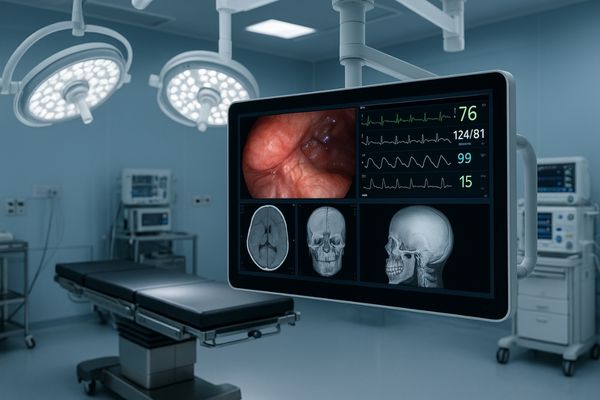
The surgical display is no longer just a screen; it is the surgeon’s visual command center. It integrates data from multiple sources and presents it with the clarity and reliability needed for complex procedures. The performance of this single piece of equipment directly impacts surgical precision1, team efficiency, and patient safety. In the sections that follow, we will explore the five key roles that a purpose-built medical display2 must fulfill to meet the demands of today’s operating room environment.
Real-Time Visualization Enhances Surgical Precision
During minimally invasive surgery, a delayed image can lead to a critical error. This lag between your action and the visual feedback undermines surgical confidence and control.
Real-time visualization provides surgeons with instantaneous visual feedback. This low-latency performance is essential for precise hand-eye coordination when guiding instruments like endoscopes or catheters, ensuring maneuvers are both accurate and safe.
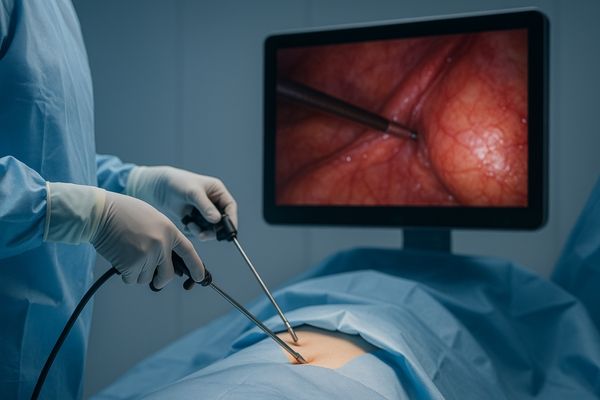
In any minimally invasive procedure, the surgeon’s eyes are fixed on the monitor. The display provides their only view of the operative field. Any delay, or latency, between the movement of an instrument inside the patient and its appearance on the screen can be disorienting and dangerous. This lag can cause a surgeon to overshoot a target or fail to react in time to an unexpected event, such as bleeding. For this reason, minimizing latency3 is a primary design goal for any surgical display. We engineer our monitors with advanced signal processing to ensure this delay is imperceptible. This creates a seamless connection between the surgeon’s hands and eyes, which is fundamental to the very concept of video-assisted surgery4. The MS275P – 27" 4K Surgical Monitor, for example, is built to deliver this near-instantaneous feedback, giving surgeons the confidence to perform intricate tasks with high precision. This is not a luxury; it is a core requirement for patient safety.
High Brightness Displays Improve Visibility Under Surgical Lights
Intense surgical lights are essential, but they create powerful reflections on monitor screens. This glare can wash out the image, forcing you to squint and lose focus.
High-brightness displays use powerful backlights to produce a vivid image that is not washed out by intense overhead surgical lighting. Paired with anti-glare surfaces, they ensure excellent visibility and contrast from any angle in the operating room.

The operating room is one of the most brightly lit environments in any hospital. While this is necessary for direct vision, it creates a significant challenge for video displays. The ambient light can easily overpower a standard monitor’s backlight, causing the image to appear faded and desaturated. Darker areas of the image, which often contain critical anatomical information, can lose all detail. To combat this, https://reshinmonitors.com/top-medical-display-manufacturers-2025/5 must have a significantly higher brightness output6 than consumer or office monitors. Brightness is measured in candelas per square meter (cd/m²), or nits. While a typical office monitor may have 250-300 nits, a surgical display often needs to be 800 nits or higher. This high brightness is paired with an advanced anti-glare screen surface that diffuses reflections from overhead lights. The MS321PB – 32" 4K Surgical Monitor is designed with these conditions in mind, providing a bright, clear picture that maintains its contrast and color fidelity even in the most challenging lighting, ensuring the entire surgical team has an uncompromised view.
Display Brightness Recommendations for OR Environments
| Brightness Level (cd/m²) | Suitability for OR | Typical Use Case |
|---|---|---|
| 250 – 350 | Unsuitable | Standard Office/Desktop Monitors |
| 400 – 600 | Adequate for some low-light rooms | Endoscopy, Clinical Review |
| > 800 | Excellent | Brightly lit General and Hybrid ORs |
Multiple Inputs Support Diverse Surgical Equipment
A modern OR contains equipment from many vendors with different connection types. Using multiple monitors or constantly swapping cables during a procedure is inefficient and disruptive.
Surgical displays with multiple inputs like SDI, HDMI, and DisplayPort act as a central hub. They connect to all imaging equipment simultaneously, allowing surgeons to switch views or display multiple sources on one screen, streamlining the surgical workflow.
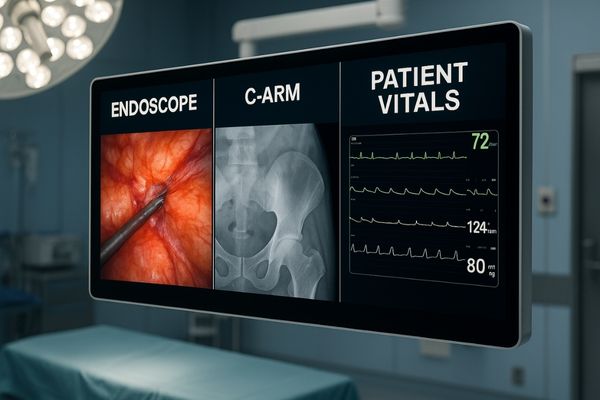
The hybrid operating room is an ecosystem of specialized technology. On any given day, a surgeon might need to view images from an endoscopic camera, a C-arm for fluoroscopy, an ultrasound probe, and a room camera, all while keeping an eye on the patient’s vitals. A versatile surgical display must be able to connect to all of these devices seamlessly. This requires a wide array of input ports, including legacy connections like DVI and modern standards like HDMI and DisplayPort. Critically, it also includes 3G-SDI (Serial Digital Interface)7, the professional standard for broadcasting high-quality video over long distances without compression or latency, which is essential for C-arms and room cameras. The ability to show these sources simultaneously using Picture-in-Picture (PIP)8 or Picture-by-Picture (PBP) layouts further enhances workflow. For example, a surgeon can follow a live endoscopic feed while referencing a pre-operative CT scan on the same screen. The MS430PC – 43" 4K Surgical Monitor is designed for this very purpose, providing the connectivity and flexibility needed to manage the complex visual demands of a fully integrated operating room.
Common Inputs on Surgical Displays
| Input Type | Primary Use in the OR | Key Advantage |
|---|---|---|
| 3G-SDI | C-arms, room cameras, legacy HD sources | Long cable runs, locking connector, low latency |
| HDMI | Modern 4K/FHD endoscopic cameras, ultrasound | Ubiquitous, high bandwidth for 4K video |
| DisplayPort | 4K/8K video sources, computer outputs | Very high bandwidth, supports advanced features |
| DVI | Older endoscopic cameras and imaging systems | Secure, reliable digital connection |
Ergonomic Designs Reduce Surgeon Fatigue
Surgeons stand for hours, often in fixed, awkward positions. A poorly designed or positioned monitor adds to this physical strain, causing neck pain and eye fatigue that can degrade performance.
Ergonomically designed displays are lightweight for easy mounting on adjustable arms. They feature wide viewing angles and flicker-free technology, which together reduce physical and visual strain, helping surgeons maintain comfort and concentration during long procedures.
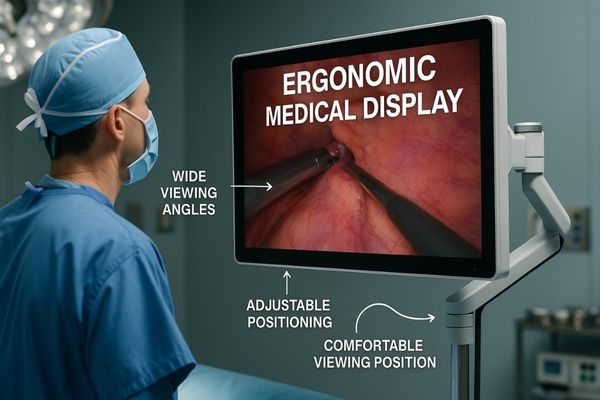
The well-being of the surgeon is directly linked to the safety of the patient. Fatigue is a significant risk factor in the operating room, and equipment design plays a large role in mitigating it. A medical display’s ergonomic features9 are therefore not minor conveniences; they are critical safety components. A lightweight design allows the monitor to be mounted on a fully articulating boom arm, so it can be positioned perfectly in the surgeon’s line of sight, regardless of their height or stance. This reduces neck and back strain. Furthermore, wide viewing angle technology is essential because the surgical team views the screen from various positions around the table. A good display maintains its image quality without color or contrast shifts when seen from off-center. Just as important is what you cannot see. Many displays use a technique called Pulse-Width Modulation (PWM) to control brightness, which creates an imperceptible flicker that leads to eye strain and headaches over time. A display like the MS270P – 27" FHD Surgical Display uses flicker-free DC dimming10, providing a stable image that is more comfortable for the eyes during marathon procedures.
Infection Control Drives Demand for Easy-to-Clean Surfaces
The operating room demands absolute sterility. Standard monitors with vents, seams, and textured plastics are impossible to properly disinfect, creating a potential reservoir for dangerous pathogens.
Displays built for infection control have a seamless, edge-to-edge glass front, a sealed housing with an IP rating against fluids, and a fanless design. This construction eliminates places for germs to hide and allows for rapid, effective cleaning.
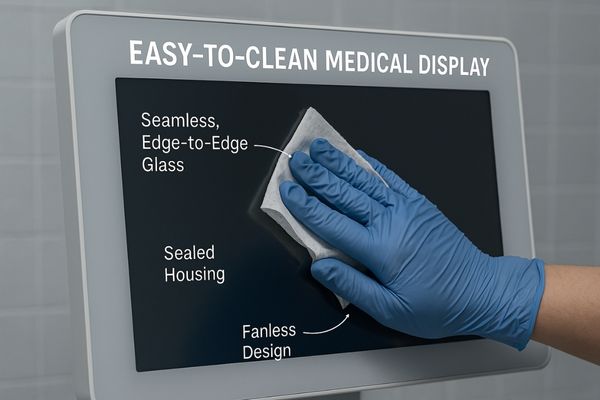
Maintaining a sterile field is the most fundamental rule of the operating room. Every piece of equipment must be designed to support this goal. A consumer-grade monitor is an immediate failure in this regard. Its cooling vents can harbor and circulate airborne contaminants, and the gaps around its buttons and plastic bezel are perfect hiding spots for bacteria. A true surgical display11 is designed from the ground up for cleanability. The front is a single, solid surface of protective glass that is sealed to the chassis, leaving no seams or gaps. This design often achieves an IP65 rating12 on the front, meaning it is completely protected from dust and can be sprayed with cleaning fluids without issue. The housing is made of chemically resistant materials that will not degrade after repeated cleanings with harsh hospital-grade disinfectants. Additionally, a fanless design not only eliminates a potential contamination point but also operates silently. The MS192SA – 19" HD Endoscopic Monitor, with its compact and fully sealed enclosure, is a perfect example of a device designed to integrate cleanly into an endoscopic tower, upholding the highest standards of infection control.
Conclusion
A medical display is a purpose-built instrument at the heart of the modern OR. It delivers the precision, visibility, integration, comfort, and sterility that are essential for successful surgical outcomes. To outfit your OR with purpose-built surgical displays, contact Reshin at martin@reshinmonitors.com.
- Understanding surgical precision is crucial for improving outcomes in complex procedures and enhancing patient safety. ↩
- Exploring the features of medical displays can help you understand their role in enhancing surgical efficiency and safety. ↩
- Understanding how to minimize latency is crucial for enhancing surgical precision and patient safety. ↩
- Exploring the benefits of video-assisted surgery can provide insights into its impact on surgical outcomes and techniques. ↩
- Explore this link to understand the essential features of surgical displays that enhance visibility and detail in operating rooms. ↩
- Learn about the measurement of brightness output in surgical monitors and why it is crucial for effective surgical procedures. ↩
- Explore this link to understand how 3G-SDI enhances video quality in medical settings, crucial for effective surgical procedures. ↩
- Discover the benefits of PIP technology in surgery, allowing surgeons to view multiple images simultaneously for better decision-making. ↩
- Exploring this resource will highlight how ergonomic features enhance surgeon comfort and patient safety. ↩
- This link will explain the advantages of flicker-free technology, crucial for reducing eye strain during long surgeries. ↩
- Explore this link to understand how surgical displays enhance sterility and safety in medical environments. ↩
- Learn about the significance of IP65 ratings in ensuring equipment durability and cleanliness in healthcare settings. ↩


